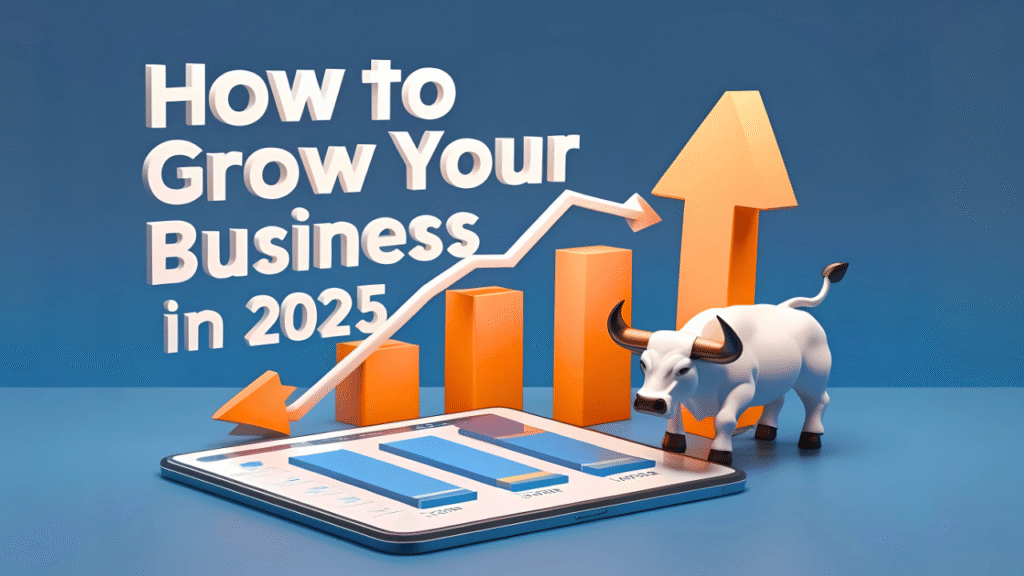Introduction
What is Business Growth and Why It Matters in 2025
In today’s fast-changing world, every business wants to grow. But growth is more than just making more money. Business growth means expanding your company’s size, value, reach, or impact. It could include hiring more people, getting more customers, entering new markets, or improving products and services.
In 2025, growth is not only a goal—it is a requirement for survival. Competition is stronger, technology is changing faster, and customer expectations are higher. Whether you run a small startup or a well-established company, understanding how to grow your business is key to long-term success.
This guide will explain what business growth really means, the common growth stages, and the top strategies to grow a business. You’ll also learn how marketing, customer acquisition, and product development play a major role in this journey. Whether you’re just starting out or looking to expand, this article will give you practical steps to move forward.
Understanding Business Growth
What Is Meant by Business Growth?
Business growth means increasing the size, capacity, and value of a company over time. This can happen in different ways—more sales, more customers, larger teams, new locations, or launching new products. Growth also includes improving internal systems, profits, and brand value.
Growth can be:
- Organic – When a business grows naturally by improving products, services, and marketing.
- Inorganic – When growth happens through buying other businesses or forming partnerships.
The right kind of growth helps businesses survive in competitive markets, meet changing customer needs, and improve long-term value.
The 5 Stages of Small Business Growth
According to the popular HBR article The Five Stages of Small Business Growth, most small businesses move through five key stages:
- Existence – Focus is on getting customers and delivering products or services.
- Survival – The business is earning enough to stay alive and cover basic expenses.
- Success – The company becomes stable, and the owner must choose: maintain or expand?
- Take-off – Growth speeds up. Systems, delegation, and leadership become essential.
- Resource Maturity – The business is strong but must manage finances, structure, and control.
Each stage has unique challenges. Understanding where your business stands helps you apply the right strategy at the right time.
Types of Business Growth Strategies
What Are the 4 Growth Strategies?
There are four main strategies businesses use to grow. These are part of the Ansoff Matrix, a popular marketing model:
- Market Penetration
Focus on selling more of your existing product to your current market. This includes improving customer service, offering discounts, or increasing brand awareness. - Market Development
Sell your existing products in new markets. This could mean targeting a new location, age group, or industry. - Product Development
Create new products for your existing customers. This helps keep current buyers engaged and increases your average sale. - Diversification
Launch new products in new markets. This is a high-risk, high-reward strategy best used by established businesses.
How Can a Business Grow?
A business can grow in many ways, depending on its goals, resources, and market. Common methods include:
- Improving marketing efforts
- Expanding to new locations or markets
- Offering new products or services
- Partnering with other businesses
- Improving customer retention and satisfaction
- Hiring skilled employees and training teams
Successful growth also depends on clear planning, tracking performance, and staying flexible to adjust strategies when needed.
Which Business Is Easy to Grow?
While no business is truly “easy” to grow, some are more flexible and scalable than others. These include:
- Online businesses – Low startup cost, global reach, and automation-friendly.
- Service-based businesses – Skills-based services like digital marketing, coaching, or consulting can grow with reputation and referrals.
- Franchise models – Tested systems and support make growth easier with less risk.
- Productized services – Turning a service into a repeatable package makes it easy to sell and scale.
The key is to start small, test your idea, and focus on solving a real problem in the market.
Also Read This: Understanding High-Risk Merchant Accounts: What They Are and How to Open One
Marketing for Business Growth
What Is the Role of Marketing in Business Growth?
Marketing is one of the most powerful tools to grow a business. It helps you reach the right audience, explain your value, build trust, and encourage people to buy. Without strong marketing, even the best products can go unnoticed.
Marketing supports growth by:
- Increasing brand awareness
- Attracting new customers
- Building customer loyalty
- Promoting new products and offers
- Creating a consistent business identity
Marketing also gives you data. You learn what people like, how they behave, and what they need—this helps you improve and grow faster.
How to Create a Marketing Strategy
A clear marketing strategy gives your business direction. It helps you focus your time, money, and energy where it matters most.
Here are the key steps to create an effective marketing strategy:
- Know your audience – Understand their age, needs, income, and interests.
- Set goals – Do you want more leads, website traffic, or brand visibility?
- Choose your channels – Social media, email, Google ads, SEO, or offline marketing.
- Create valuable content – Solve problems, answer questions, and build trust.
- Track your results – Use tools like Google Analytics or social media insights to measure progress.
How to Promote a Product
Product promotion is all about making people aware of your product and convincing them to try it. You can use:
- Social media ads (Facebook, Instagram, YouTube)
- Influencer marketing (using trusted voices to promote)
- Email campaigns (sending updates and offers)
- Free trials or samples
- Launch events or webinars
Use clear language, highlight the product’s benefits, and always include a call to action like “Buy Now” or “Get Started.”
How to Market in 2025
Marketing in 2025 is more digital, personal, and fast-paced than ever before. To stay ahead:
- Focus on short videos (like Instagram Reels or TikToks)
- Use AI tools for content creation and customer support
- Offer personalized experiences through email and chat
- Prioritize mobile-friendly content
- Invest in SEO for long-term traffic
- Be present where your customers spend time
People want real, helpful, and trustworthy content—give them that, and your business will grow.
What Is Digital Marketing?
A Closer Look at Digital Marketing Channels

- Search Engine Optimization (SEO)
SEO helps your website rank higher on search engines like Google. When people search for topics related to your business, strong SEO increases your chances of showing up on the first page—bringing free, organic traffic. - Social Media Marketing
Promoting your brand on platforms like Facebook, Instagram, LinkedIn, and TikTok helps you build relationships, share updates, and connect with your target audience where they already spend time. - Email Marketing
Email is one of the most cost-effective channels. Sending newsletters, promotions, and helpful tips keeps your audience engaged and encourages repeat business. - Content Marketing
Creating blogs, videos, or guides that solve problems or answer questions builds trust and authority. People are more likely to buy from brands that educate them. - Pay-Per-Click (PPC) Ads
These are paid ads that appear in search results or social media feeds. You only pay when someone clicks your ad, making it easier to control your budget. - Affiliate Marketing
This is when others promote your product and earn a commission for every sale they help you make. It’s a great way to grow without doing all the marketing yourself.
Customer Acquisition Strategies
How to Attract New Customers
Getting new customers is key to growing your business. Here are effective ways to do it:
- Offer value first – Give free tips, samples, or resources to build trust.
- Use social proof – Show reviews, testimonials, or case studies.
- Be where your customers are – Use the right platforms, whether online or offline.
- Run special promotions – Discounts, limited-time offers, and bundles can attract first-time buyers.
- Network and collaborate – Partner with other businesses or influencers to reach new audiences.
Consistency is important. People rarely buy after one interaction. Stay visible, helpful, and professional.
How Do I Attract My First Client?
If you’re just starting out, focus on personal outreach:
- Tell your friends, family, and connections
- Join local business groups or online communities
- Offer a discount for the first few clients
- Give extra attention and service to early customers—they can become your best promoters
- Ask for honest feedback to improve
Be confident, even if you’re new. People buy from those who believe in their own product or service.
What Is Target Marketing and Product Positioning?
Target marketing means focusing your efforts on a specific group of people who are most likely to buy from you. Instead of trying to reach everyone, you aim for the right audience. This saves money and improves results.
Product positioning is how you present your product in the minds of customers. It answers the question: Why should I buy this instead of something else?
To position your product well:
- Highlight unique benefits
- Use clear and simple language
- Focus on solving a real problem
- Show what makes you different from competitors
Product and Differentiation
Why Is Product Important in Marketing?
Your product is the foundation of your business. No matter how great your marketing is, it won’t work if the product doesn’t meet customer needs.
A strong product:
- Solves a real problem
- Delivers value clearly
- Matches customer expectations
- Is easy to use and understand
- Offers consistent quality
In marketing, the product must be presented in a way that highlights its benefits, not just its features. For example, instead of saying “Our software has real-time updates,” you say, “You get the latest info instantly, saving you time and effort.”
What Is Product Differentiation?
Product differentiation means showing how your product is different—and better—than others in the market. It’s a key part of convincing people to choose you over competitors.
Ways to differentiate include:
- Unique features or design
- Higher quality or durability
- Better pricing or value
- Special services (e.g. faster delivery, 24/7 support)
- Brand personality or story
Example: Two coffee shops can sell the same drink, but one may stand out by using organic beans, eco-friendly cups, or offering a cozy atmosphere. That’s product differentiation.
What Is a Service in Marketing?
A service is an intangible product—something you do for a customer instead of giving them a physical item. Examples include consulting, cleaning, designing, or repairing.
Marketing a service involves:
- Explaining the benefits clearly
- Building trust (since people can’t see the service in advance)
- Showing expertise with testimonials, reviews, or case studies
- Offering guarantees or free trials to reduce risk
Because services can’t be touched or tested beforehand, customer experience becomes very important in building your reputation.
Conclusion
Grow Your Business with Smart Strategies and Consistent Action
Business growth doesn’t happen overnight—but with the right mindset, strategies, and tools, it becomes a clear and achievable goal. Whether you’re just starting out or managing a growing company, the steps are the same: know your market, create real value, promote effectively, and stay connected to your customers.
In this guide, we covered:
- What business growth means and how it happens
- The 4 main growth strategies and how to use them
- The role of marketing in driving growth
- How to attract new customers and keep them coming back
- Why product quality and differentiation matter
In 2025 and beyond, success belongs to those who stay focused, adapt to changes, and keep learning. Don’t try to do everything at once—choose one or two strategies, test them, improve, and grow step by step.
Your next customer, breakthrough, or big growth opportunity could be just one smart move away.

